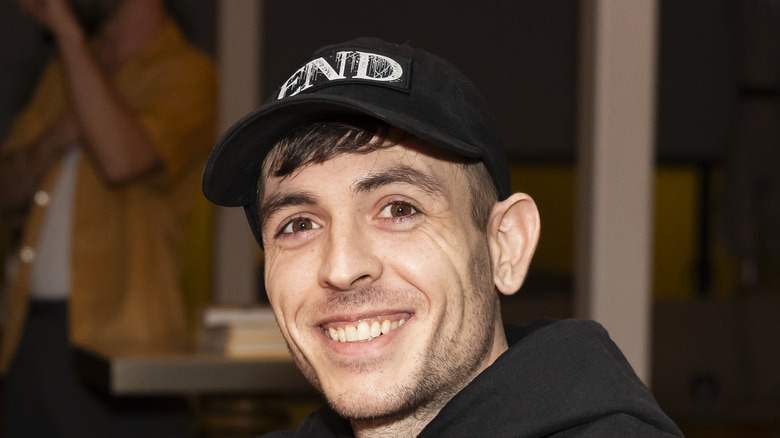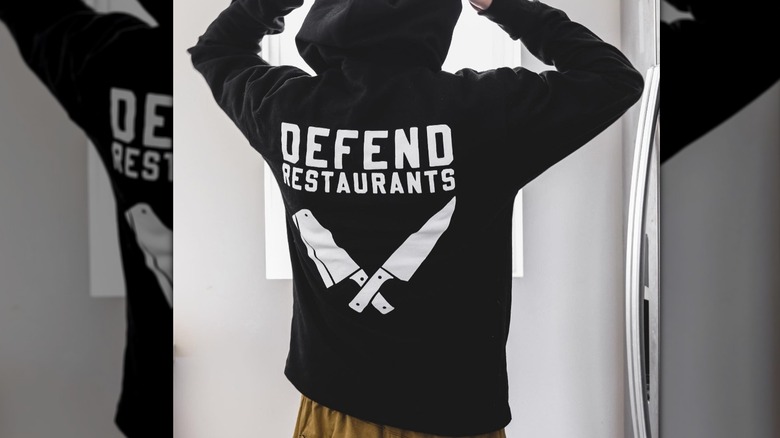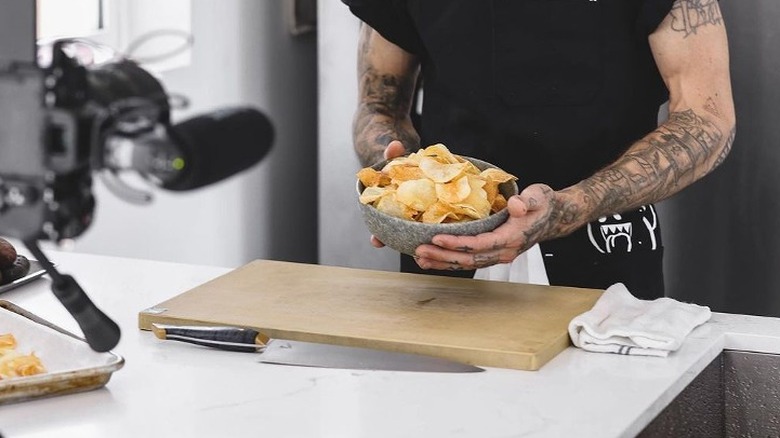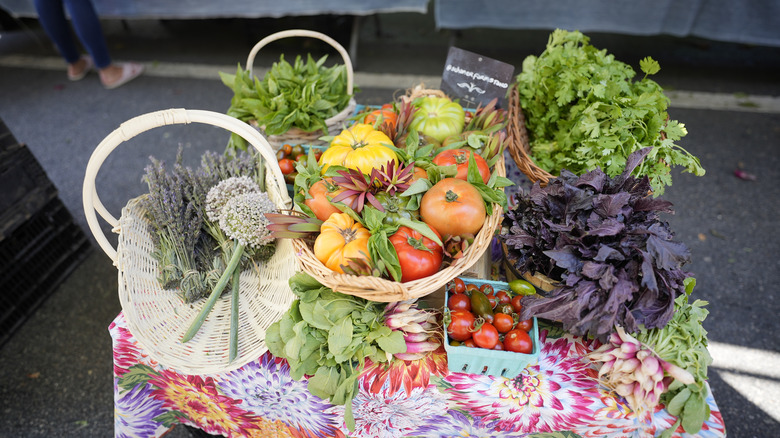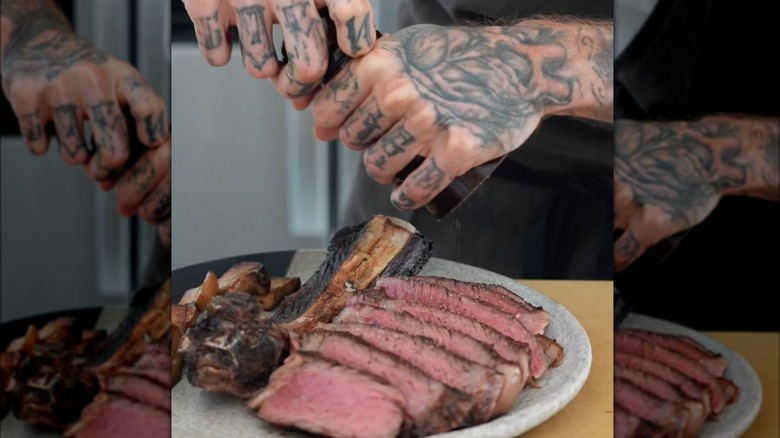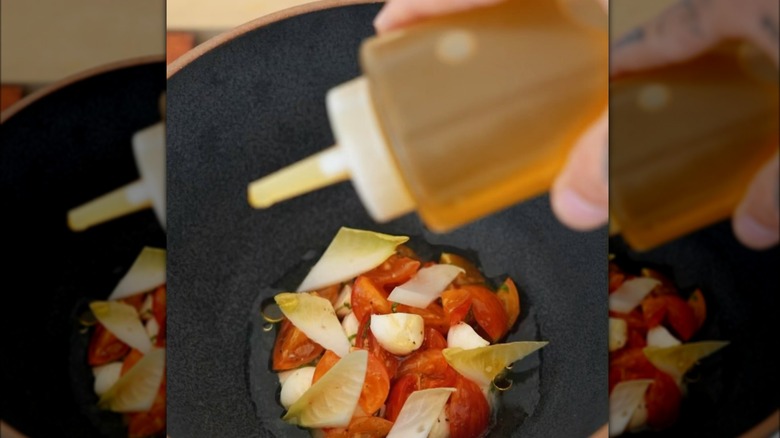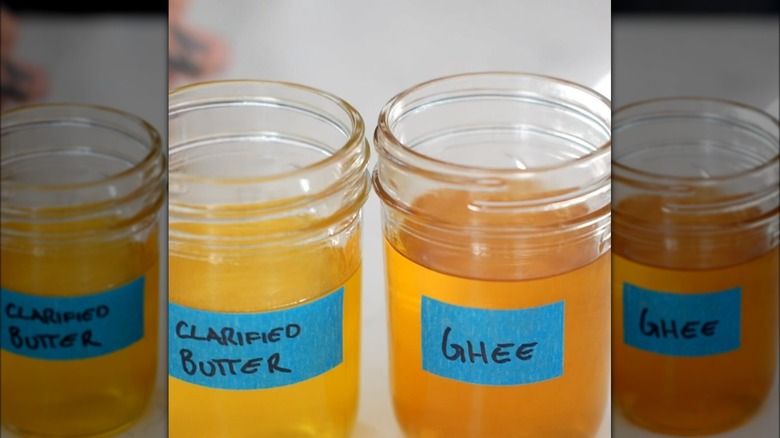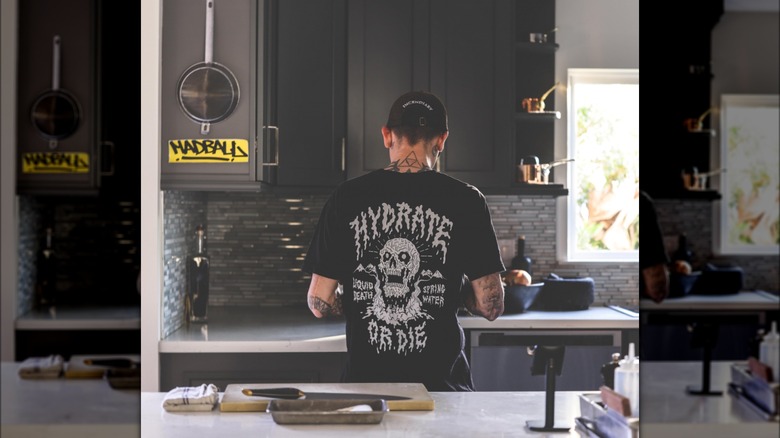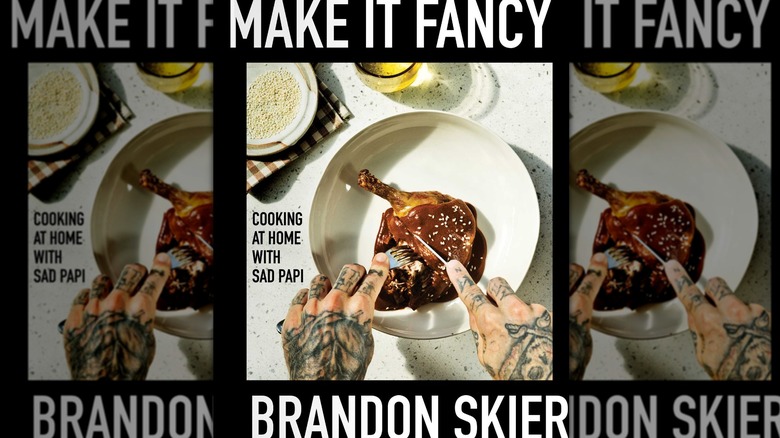Brandon 'Sad Papi' Skier Wants To Bring The Restaurant Experience Into Home Kitchens - Exclusive Interview
Brandon Skier was grinding it out in some of LA's best restaurants before the pandemic terminated his gig as a line cook. No stranger to hard work and thinking on his toes, Skier began posting videos on TikTok of techniques he'd gleaned from working back-of-house, like how to char leek scraps to make a flavorful powder and how to cure an egg yolk for shaving over pasta.
Fast-forward to 2024, and Skier — who goes by the name Sad Papi on social media — has amassed an audience of two million. With a surplus of recipe content today that caters to the short-order cook, Skier uniquely prizes results over speed and simplicity. His culinary-savvy followers, who call themselves "Papitas," flock to his channels to mimic how contemporary chefs add maximal flavor, texture, and depth to familiar ingredients and dishes.
In his new book, "Make It Fancy: Cooking at Home with Sad Papi," Skier proves the boundary between the home and restaurant kitchen no longer exists. From bordelaise to California kosho, the book spans cuisines and techniques, balancing French classical with LA's playful contemporary. We sat down with the cook-turned-content creator in this exclusive interview to learn how he adapts his cooking for the home kitchen without losing sight of the hacks that make restaurant food so surprising and special.
Skier worked his way up in restaurants
You've cooked at some of the best restaurants around LA. How did you get your start working in kitchens?
So I got my start like most kids in the 90s. Chef culture was super popular. "Iron Chef" was coming up, and Gordon Ramsey was taking off, and he had a million shows. My dad was super into it because he was a line cook when he was younger, so I was always cooking. He was always dragging me in the kitchen. My first job, I became a manager for a body shop. I was sitting behind a desk and doing deliveries with customers all day. I hated it so much. So I quit. Got that minimum wage.
I kept doing that, took my savings from my manager job, went to culinary school. What I used to do is Jonathan Gold's 101 Best Restaurants List. It was like the unofficial Michelin guide for LA when the guide didn't come here. I started going down the list and applying to every single restaurant I thought was interesting.
I would get hired, and then I would be like, "Okay, I need to go up the list." I started at [number] 87, at this restaurant, Plan Check. Then next, I was like, "Okay, I want to go to Redbird." Redbird was at 30 at the time or something. So I went to Redbird and I applied and they actually said no the first time. I only had a year of experience, so it made sense. But I went back and I applied again a couple of years later and I got the job and then I just worked my way all the way up the list.
Then I ended up at Auburn, which was a new restaurant that had just opened, but that restaurant was killing it. We were winning awards left and right. We got a really good write-up from the LA Times and all kinds of stuff, but then COVID happened.
Which restaurant gig has influenced you the most?
I would say that Auburn was probably the most influential to me because chef Eric [Bost] was so different. He was a good teacher. He wanted you not only to do the food perfectly because he wanted it perfect but because he wanted to teach you. He made a really big impact on me as a cook. And the restaurant culture there was just so different. Everyone was close. I've been in a couple of really toxic kitchens. You go through the motions. Your station partner doesn't like you; they blame [you] for everything. But Auburn, Auburn was operating at such a high level, and everyone liked each other, so it was just such a good experience.
There was a learning curve to creating content
You had to pivot during the pandemic from working in restaurants to creating content. There's an anecdote in your book about starting out filming on an iPhone with a cracked screen. What's been the most challenging part about switching careers for you?
The technology hurdle. I was a line cook. I was broke. I didn't even have a computer when I started, so I had to buy a computer, teach myself computer literacy, and then download the editing software. I had to get a camera, teach myself how to use a camera, and then how to edit. I thought, "Okay, I can get by with this."
And then I was like, "Oh no, no. Now you need to learn how to edit pictures and you need to do lighting and you need to do this and that." So, the technology hurdle was the biggest one for me.
It's complex. There are so many different devices and gadgets and things you need to learn
Exactly. Because once you film, it's not like it looks great. You have to color grade, and you have to fix things and touch things up, and yeah, it was crazy. A lot of people don't think about it. Because with food content, you have to buy the food, and then you have to work and prep the food and cook the food and make it look good, and then you have to write down the recipe, and then you have to edit and do all that other nonsense, and then you have to post and upload and talk to everybody. It's a lot more than just lifestyle content.
How did you score the name Sad Papi, and why do you think this persona is so relatable?
It was a joke. My friends gave [it to] me. So I used to have a different handle, and then I had a really bad accident and I had surgery on my arm and they were like, "You're no longer just Papi. Now you're just a sad Papi." I thought it was hilarious, so I changed my handle. I had no intention for it to stick. I didn't plan on that being my moniker, but there it is. I mean, it's just silly, but it's okay, I like it.
Los Angeles' cuisine inspires Skier
The recipes in your new cookbook, "Make It Fancy," span cuisines, but there's a distinctively LA through line. What techniques or ingredients would you say characterize the food coming out of the LA dining scene at the moment?
One thing that LA has is produce. Fresh, really good produce, and then also just the melting pot. I grew up here. I'm one of the few who was actually born and raised here. I would go to Boyle Heights and get tacos, then I would go to Chinatown and eat dim sum for lunch, and then I would go to Thai town and eat Thai food for dinner. That's what I grew up eating and it's reflected in the book, flavors from all over the place that you wouldn't normally pair together, but they do work together.
Where do you get your inspiration for a new dish?
I eat out a lot. I think most cooks can relate. Going out to eat at a new restaurant is like doing homework, like, "Oh, this was really cool." And then also just my friends. Me and my friends will start talking about food and we'll just bounce ideas off of each other. I still have a lot of friends in the food space, line cooks and chefs. My friend is opening a restaurant pretty soon, and we're just bouncing food ideas off of each other for the opening. A lot of my inspiration comes from eating [out] and other people.
What Skier channeled from his restaurant experience to the page
Were there any techniques you purposely avoided including in the book? Any that were the bane of your existence when you were working in kitchens?
Any techniques I avoided? No, not particularly. I think I just tried to avoid any tedious minor details. I did include it once — but it was for dessert — I used to do things like peel and blanch pistachios, which was just beyond time-consuming. We would have one person in between pick-ups, just peeling pistachios all night for one dish. I tried to avoid stuff like that. I didn't want people to do tedious things, but I don't think there are any techniques that I would otherwise call annoying, the bane of my existence. They're all approachable for the most part.
I tried not to make it too fiddly. There were a lot of dishes where you would run something on the slicer and make these really small ribbons, and then you would saute the ribbons perfectly flat in butter, and then to plate it, you would use your tweezers and coil it and shape it and make it this whole ordeal. I tried to avoid anything like that. I tried to keep it pretty meat and potatoes, straightforward and simple. I guess avoiding tweezer work.
Your book pushes against the zeitgeist of making things minimal and simple, yet you have millions of followers. Why do you think your food has gained so much traction?
I think I've made it clear from the very beginning. [Some] of the things that I do take time, but they're not meant to be made every single day. They're meant for special occasions. They're meant for birthdays and holidays and anniversaries and stuff like that, which is okay. You don't need to make one of my recipes every single day, but it's going to be worth it. And isn't that what restaurants are about? You go out to a restaurant for an experience. You don't go somewhere fancy every single day, or most people don't. But I communicate through food, so I think cooking for someone and doing something really over the top and really nice at home is such an excellent way to communicate love.
What is your favorite menu to cook when you're having people over?
I try to do large format, share kind of style — so a couple of the proteins in the book, like the rib steak or the whole grilled fish, stuff like that. I like doing share plates like that with just a bunch of sides around. Yeah, I like family-style serving.
Creativity meets accessibility on the pages of 'Make it Fancy'
Powders, gels, and foams have a reputation for being stuffy. Yet some of your recipes — like burnt onion powder, potato crumbs, and puffed grains — read fresh and modern. How did you pull that off?
A lot of it is just pulling from my experience in restaurants, like the potato breadcrumbs, the technique of putting a potato in the blender, but only doing it enough to where it's just a small crumble. I just thought that was so cool, and I just started experimenting. I like scotch eggs with potato breadcrumbs instead of just traditional breadcrumbs, and it was rad.
I gave it to a friend, and he was just like, "I can't place it, but this isn't bread. I don't know what it is." And I was like, "It's good, right?" But I don't know, I guess it's just trying to do things a little bit differently, but pulling from my experience. A lot of the stuff is stuff that I've done in restaurants.
Right. The things that intrigued you the most.
Yeah, but it's still attainable. Like the gel that's in the book, there's no agar, there's no setting agent. You're clearly just using the pectin, which is already there. So once you understand what pectin is, you can just take advantage of it and you can make something that looks really fancy, but it's really not. All you're doing is blending lemons until they're really hot, activating that pectin.
Do you have any other recipes or ingredients that you like to showcase the gel technique with?
You can do it with any citrus realistically, but I like doing it with preserved lemon in particular, just because it has that unique funky flavor, the floral flavor of a preserved lemon.
What other dishes do you like to use preserved lemon in?
I really like putting just a little drop on an oyster, because it reminds me of a mignonette, the acid and a little bit of lemon and citrus going on, but in a different format. I really like doing it with fish in general, smoked fish, cured fish. Stuff like that.
Some of the dishes you feature are surprisingly simple, like blistered grapes with stracciatella and saba. What are your favorite techniques from "Make it Fancy" when you don't have a ton of time in the kitchen?
I think it comes to having your pantry stocked. If you just have crunchies or puff grains or something like that, you can just throw together a couple of items and then throw something on top, and it becomes immediately more full, and it's more of an experience.
The pantry is the difference between a home cook and a home chef
In your book, you state that the main difference between the best home cook and a restaurant chef is their pantry. Which overlooked pantry items should home cooks always have on hand, and how should they use them?
The best pantry items to have on hand are crunchies, and what I mean by that is if you have a bunch of nuts and seeds in your pantry that have been sitting there and you don't know what to do with them, throw together a spice mix. Add a bunch of nuts, add a bunch of seeds, and make it taste really good, like dukkah. I love dukkah. I use it all the time. It's a great way to add texture and a lot of seasoning over the top of something with low effort. You make it once, and then you can use it 10 times.
What are some of your favorite applications for using dukkah in your day-to-day life?
I use it a lot on breakfasts. I'll throw it on top of some greens. If I have some sad spinach, I'll wilt it quickly, throw in a handful of dukkah, toss it, and throw it on the plate. It tastes really good.
Are there any canned items that you can't live without?
Tomatoes. I love canned tomatoes. I'm also a fan of canned beans. I love throwing together a tomato sauce, like pasta. I can do it in 30 minutes. I've posted a video about it, actually. It's something I fall back on. If I didn't go grocery shopping, I usually have a can of tomatoes and I can make pasta really quickly.
And then canned beans. I like making a quick soup. If I have some onion and garlic, I'll chop them up real quick, throw in some beans and maybe just a splash of vegetable stock, and then throw in whatever else I have for a makeshift soup on the fly ... I like black beans, I like cannellini beans. All beans are good. I'm a fan of all beans.
If a home cook were to keep one thing in their freezer at all times to amplify a dish, which would it be?
I think gnocchi. I think I would keep gnocchi around at all times because you just roast some potatoes and you shape your gnocchi. You can blanch them and then you can freeze them, and you can portion them out, pull them out whenever you want a meal. And then it goes back to canned tomatoes. You have a can of tomatoes, you make a quick tomato sauce, and then you have a pretty fancy gnocchi dinner with low effort.
Managing time and reducing overwhelm
Do you have any tips for managing your time and staying organized in the kitchen when you're preparing a dish with lots of steps?
I work off of a list. I make myself a little prep list. I highly advocate this. I have a whiteboard as well, so I walk past it every day, and I'm like, "What do I need to do today?" And if I'm making something with a lot of steps, I try to plan it out, so if I'm going to make the rib steak with mushroom reduction, it's like, "Okay, do I have mushroom stock?" Maybe I'll throw that on there. "Do I have beef stock? Do I need to make beef stock?" Throw that on there. Salt the rib a day before; put that on the list. So I'm very much a list person. I work off lists and then timers.
Are there any kitchen tools your audience would be surprised to learn you cannot live without?
My bench scraper, I use that thing religiously. I use it when I'm doing knife work, and I'm scooping my stuff. If I'm cleaning and scraping my bench, if I need to get everything out of a plastic bag by forcing it all forward — my bench scraper. The rubber spatula is a close second.
Your plating is so artful. Do you have any tools or advice on making your food not just taste fancy but look fancy, too?
I always just try to keep things somewhat symmetrical. People really like symmetry. It's why we design cars the way that we do. It's why we like furniture the way that we do. Everything is designed to look symmetrical, so I just try to start with symmetry and build off of it.
Pops of color here and there are good. Nobody likes gray or monotone food, but I don't think I do anything particularly out of the ordinary to make things colorful. I try to gravitate towards colorful ingredients in the first place. If I am making a salad, maybe don't go for just iceberg. Grab a mesclun mix that has some color throughout there in the first place, just for contrast. If something is looking really red, maybe I'll add some different pops of beige on top, like the gnocchi has garlic chips all over the place, just to break it up so it doesn't look too Christmas-sy.
Skier's love of potatoes goes beyond gnocchi
Your tattoos — let's talk about them. They're an iconic part of your brand. Do you have any food-related ones with a good backstory that you could share with us?
Yeah, I have a strawberry tattoo on me, and then I have a dancing potato tattooed on my thumb. And I think the potato is probably more iconic because I used to post a lot of potato recipes, so much so that I got a nickname with my fans called The Potato Papi. So yeah, I was Potato Papi, and then I was having this whole thing with my friend and we were naming our followers, and I put it up to a vote and I was like, "What do you guys want to be called? I don't want to just name you guys. That doesn't feel right." And they voted on The Papitas. Yeah, so a lot of potato things; I got a potato tattooed on me.
What's your favorite potato recipe?
I think dauphinoise potatoes. I just love a good, messy, fatty, creamy potato. Or even something simple, like fourchette potatoes, roasted, smashed with a fork with some olive oil. That's good, too. They're all good.
"Make It Fancy: Cooking at Home with Sad Papi" is now available for purchase here. Keep up with all things Brandon Skier and Sad Papi on Instagram and TikTok.
This interview was edited for length and clarity.
